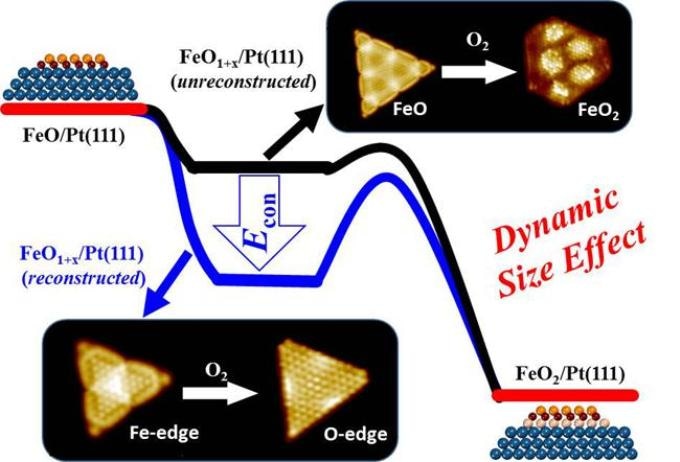Feb 24 2017
 This is a schematic illustration of the dynamic size effect in enhancing the oxidation resistance of active FeO NSs. CREDIT: Image by Yang Fan.
This is a schematic illustration of the dynamic size effect in enhancing the oxidation resistance of active FeO NSs. CREDIT: Image by Yang Fan.
A research headed by Professor Bao Xinhe from the Dalian Institute of Chemical Physics, Chinese Academy of Sciences, has concluded that the oxidation resistance of oxide nanostructures (NSs) with a diameter less than 3 nm can be far higher than larger NSs. For the first time, the research team analyzed the oxidation mechanism at the atomic level and suggested that a “dynamic size effect” controls the stability of supported nanoparticles.
The outcomes of the research have been reported in an article titled “Enhanced oxidation resistance of active nanostructures via dynamic size effect,” published in the latest issue of the journal Nature Communications.
In addition to providing an atomic understanding of the dynamic remodeling mechanism of nanocatalyst under atmospheric conditions, the study also offers an innovative interface control for developing an anti-oxidation and anti-corrosion nano-protective coating.
One of the main difficulties prohibiting the practical use of nanomaterials is the fact that the NS activities increase with reduction in size, generally losing their stability under a chemical environment. When subject to oxidative conditions, smaller sized NSs with higher defect densities are usually anticipated to be more readily oxidized. This is because of the fact that high-concentration defects aid oxidation by improving the reactivity with O2 and by offering a fast channel for oxygen incorporation.
However, earlier, a number of nanocrystalline materials were found to have enhanced oxidation resistance when compared to bulk materials. Such nanocrystalline materials have also been used as anti-corrosion coatings.
The absence in a common agreement about the oxidation resistance of oxide NSs is due to the restricted knowledge of the undivulged oxidation mechanism. Specifically, there have been very few studies related to the oxidation kinetics of NSs with diameters less than 5 nm.
Consequently, Bao’s research team and Professor Yang Fan developed FeO NS of varied sizes on Pt (111) and analyzed their oxidation kinetics by means of high-resolution scanning tunneling microscopy (STM) as well as density-functional theory (DFT) computations.
When the size of active FeO NS was reduced, their oxidation resistance was observed to increase dramatically, and maximum oxidation resistance was observed for FeO NS of dimensions less than 3.2 nm. The researchers discovered that the improvement in oxidation resistance was due to the size-dependent structural dynamics of FeO NS in O2.
Particularly, the research demonstrated that FeO NSs of sizes less than 3.2 nm were able to go through a complete and facile reconstruction when O2 gets dissociated at the coordinatively unsaturated ferrous centers positioned at the edges of FeO NSs.
Following the reconstruction, the dissociated oxygen atoms get stabilized at the FeO NSs edges and were unable to infiltrate into the Pt and FeO interface, restricting further oxidation of FeO NSs. FeO NSs of dimensions greater than 3.2 nm can be easily oxidized. This is due to two reasons: their incapability to complete the reconstruction, and the occurrence of surface dislocations.
Put differently, small-sized FeO NSs are more receptive to dynamic reaction changes, and thus attain a comparatively stable structure. The researchers call this a “dynamic size effect,” which was observed to control the chemical characteristics of active NSs. In order to establish the universality of dynamic size effect, the research team also analyzed CoO NSs supported on Au (111) or Pt (111). They discovered that NSs with dimensions less than 3 nm exhibit similar oxidation-resistant properties.